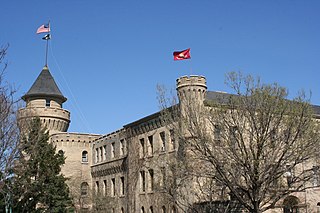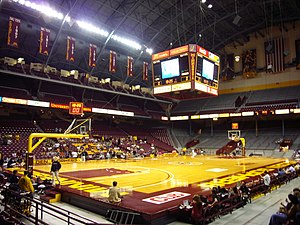
Target Center is a multi-purpose arena located in Minneapolis that opened in 1990. It hosts major family shows, concerts, sporting events, graduations and private events. Target Corporation, founded and headquartered in Minneapolis since 1902, has held the naming rights to the arena since its opening.

The University of Minnesota is a public land-grant research university in the Twin Cities of Minneapolis and Saint Paul, Minnesota, United States. The Twin Cities campus comprises locations in Minneapolis and Falcon Heights, a suburb of St. Paul, approximately 3 mi (4.8 km) apart. The Twin Cities campus is the oldest and largest in the University of Minnesota system and has the ninth-largest main campus student body in the United States, with 52,376 students at the start of the 2021–22 academic year. It is the flagship institution of the University of Minnesota System, and is organized into 19 colleges, schools, and other major academic units.

3M Arena at Mariucci is the home arena for the Minnesota Golden Gophers men's ice hockey team of the University of Minnesota. The arena is located on the Minneapolis campus and seats approximately 10,000 fans. The arena opened in 1993 and is named after John Mariucci, the longtime Gopher coach who is considered the "godfather of Minnesota hockey." Under the gate is a quote from Mariucci: "Through these gates walk the greatest fans in college hockey." The ice sheet was Olympic sized from 1993 to 2023, when construction began on reducing the rink floor size. The women's ice hockey team played at Mariucci from 1997 until 2002 when they moved to Ridder Arena, which is connected to Mariucci via a tunnel.

The Minnesota Golden Gophers are the college sports teams of the University of Minnesota. The university fields a total of 21 teams in both men's and women's sports and competes in the Big Ten Conference.

The Joyce Center, formerly the Athletic & Convocation Center, is a 9,149-seat multi-purpose arena in Notre Dame, Indiana just north of South Bend. The arena opened its doors in 1968. It is home to the University of Notre Dame Fighting Irish basketball and volleyball teams. The main arena, Phillip J. Purcell Pavilion, is located in the southern portion of the facility. The northern portion housed a hockey rink until October 2011. It is also home to the Castellan Family Fencing Center and Rolfs Aquatic Center in the rear of the building.

Ridder Arena is an indoor ice rink at the University of Minnesota, and home to the Minnesota Golden Gophers women's ice hockey team. The arena is adjacent to the men's 3M Arena at Mariucci. It was completed in 2002, and includes the connected Baseline Tennis Center for the men's and women's tennis teams. It was the first facility in the United States built specifically for college women's ice hockey, and has hosted the NCAA Women's Frozen Four on four occasions. The arena is named for benefactors Robert Ridder and Kathleen Ridder.

Hinkle Fieldhouse is a basketball arena on the campus of Butler University in Indianapolis, Indiana. Completed in early 1928, it was the largest basketball arena in the United States until 1950. The facility was renamed Hinkle Fieldhouse in 1966 in honor of Butler's longtime coach and athletic director, Paul D. "Tony" Hinkle. It is the sixth-oldest college basketball arena still in use. Added to the National Register of Historic Places in 1983 and designated a U.S. National Historic Landmark in 1987, Hinkle Fieldhouse is sometimes referred to as "Indiana's Basketball Cathedral."
Sports in Minnesota include professional teams in all major sports, Olympic Games contenders and medalists, especially in the Winter Olympics, collegiate teams in major and small-school conferences and associations and active amateur teams and individual sports. The State of Minnesota has a team in all five major professional leagues. Along with professional sports, there are numerous collegiate teams including the University of Minnesota Golden Gophers and St. Thomas Tommies in NCAA Division I, as well as many others across the Minnesota public and private colleges and universities.

The Minnesota Golden Gophers wrestling program is an intercollegiate varsity sport at the University of Minnesota. They are a member of the Big Ten Conference and NCAA. Wrestling began at Minnesota in 1910, but the first formal dual meet was not until 1921 when coach Frank Gilman led the team to a victory over Wisconsin. The Gophers have won the NCAA Division I Wrestling Championships team title three times, in 2001, 2002, and 2007.

John Mariucci was an American ice hockey player, administrator and coach. Mariucci was born in Eveleth, Minnesota. He attended the University of Minnesota where he played for both the hockey and football teams. He was named an All-American in hockey in 1940. Mariucci was inducted into the inaugural 1973 class of the United States Hockey Hall of Fame and was elected to the Hockey Hall of Fame as a builder in 1985.

The University of Minnesota Marching Band is the marching band of the University of Minnesota and the flagship university band for the state of Minnesota. The Pride of Minnesota serves as an ambassador for the university, representing the school at major events both on and off campus. The band performs before, during, and after all home Golden Gopher football games and bowl games, occasional away games, local parades, numerous pepfests, exhibition performances, as well as a series of indoor concerts toward the end of the regular football season. Members of the band, along with non-member students, also participate in smaller athletic pep bands that perform at other major sporting events, including men's hockey, men's basketball, women's hockey, women's basketball, and women's volleyball.

The Minnesota Golden Gophers men's ice hockey team is the college ice hockey team at the Twin Cities campus of the University of Minnesota. They are members of the Big Ten Conference and compete in National Collegiate Athletic Association (NCAA) Division I ice hockey. The Golden Gophers have won five NCAA national championships, in 1974, 1976, 1979, 2002 and 2003. The team also shared the 1929 National Intercollegiate Athletic Association championship with Yale. and captured the national Amateur Athletic Union (AAU) championship for amateur hockey in 1940. The Gophers are currently coached by Bob Motzko. Under Don Lucia the Gophers earned a spot in the NCAA tournament in eight seasons during a nine-year time span, including five number 1 seeds and three appearances in the Frozen Four. The team's main rivalries are with the University of Wisconsin and the University of North Dakota, although several other schools claim Minnesota as their archrival. For much of the team's history, there has been a strong emphasis on recruiting native Minnesotan high school and junior hockey players, as opposed to out-of-state, Canadian, or European players. This helped high school ice hockey grow in Minnesota, particularly starting with Hall of Famer John Mariucci, who refused to recruit players from Canada. Minnesota high school ice hockey programs grew from 26 in 1945 to over 150 in 1980. Head coach Doug Woog championed home-grown talent even more, only recruiting Minnesota players in the late 1980s and 1990s, but recent rosters have been more diversified.
Joel Maturi is an American university administrator. He is currently an assistant to University of Minnesota president Eric W. Kaler. Maturi was the athletic director at the University of Denver (1996–1998), Miami University (1998–2002), and the University of Minnesota (2002–2012).

The Minnesota Golden Gophers men's basketball team represents the University of Minnesota in NCAA Division I college basketball competition. The Golden Gophers competes in the Big Ten Conference and play their home games at the Williams Arena.

The University of Minnesota Armory is a building on the University of Minnesota campus in Minneapolis, Minnesota. The Armory was constructed in 1896 after the previous space for military training on the campus burnt in a fire in 1894. The facility served as the primary home for the Minnesota Golden Gophers men's basketball team as well as the University of Minnesota Marching Band after its construction. The basketball team moved to the Kenwood Armory in Downtown Minneapolis in 1925 while the band moved to the newly completed Music Education Building in 1922. Fielding H. Yost, Michigan Wolverines football coach, forgot the Little Brown Jug, one of the oldest college football traveling trophies, in the locker rooms of the Armory in 1903. The Armory was also the facility used for the University of Minnesota physical education department until 1935. The school's football team played some of their early games on the open field next to the Armory.

Sports in Minneapolis–Saint Paul includes a number of teams.

Rachel Banham is an American professional basketball player for the Minnesota Lynx of the Women's National Basketball Association (WNBA). Banham played guard for the Minnesota Golden Gophers women's basketball team, where she set a number of team records. Banham was drafted by the Connecticut Sun with the 4th pick of the 2016 WNBA draft. Banham was traded to the Minnesota Lynx on February 25, 2020. It was also announced on January 2, 2022, on social media that she and her boyfriend Andre Hollins were engaged at Williams Arena.

The 2021 NCAA Division I men's basketball tournament was a single-elimination tournament of 68 teams to determine the National Collegiate Athletic Association (NCAA) Division I men's college basketball national champion for the 2020–21 season. The 82nd edition of the tournament began play on March 18, 2021 in sites around the state of Indiana, and concluded with the championship game at Lucas Oil Stadium in Indianapolis on April 5, with the Baylor Bears defeating the previously undefeated Gonzaga Bulldogs 86–70 to earn the team's first ever title.

The 2017–18 Minnesota Golden Gophers men's basketball team represented the University of Minnesota in the 2017–18 NCAA Division I men's basketball season. The Gophers were led by fifth-year head coach Richard Pitino and played their home games at Williams Arena in Minneapolis, Minnesota as members of the Big Ten Conference. They finished the season 15–17, 4–14 in Big Ten play to finish in a three-way tie for 11th place. As the No. 11 seed in the Big Ten tournament, they lost in the first round to Rutgers.


















